Summer blooming plants like Peonies and Echinacea should be pruned in spring after the risk of frost is gone.
Spring blooming plants like Bleeding Hearts and Asters should be pruned only after they bloom so that you don't remove any future flowers.
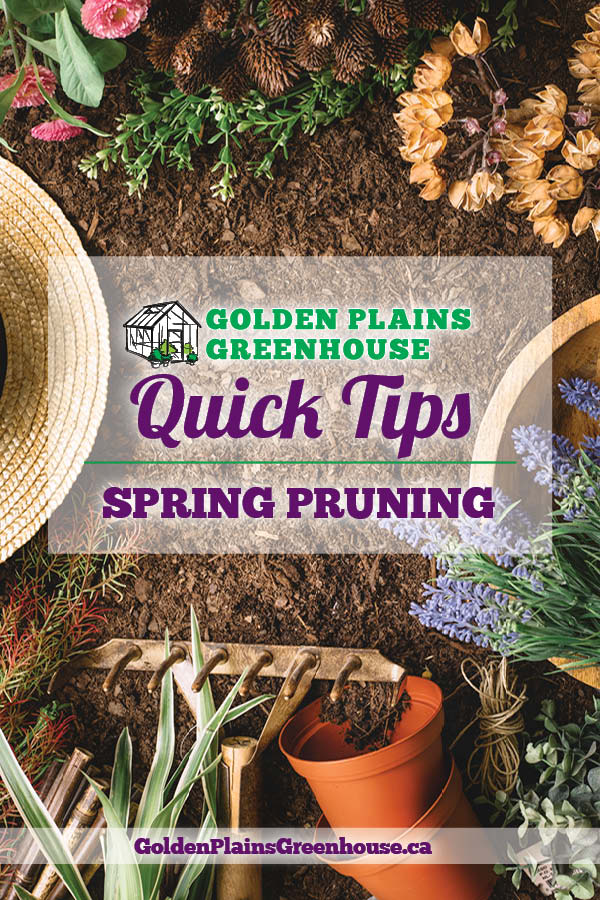
The reason why we prune plants in the spring is to stimulate growth so want to be careful not to do it too early in case of an unexpected frost (like we don't have those here!).
Summer blooming plants like Peonies and Echinacea should be pruned in spring after the risk of frost is gone. Spring blooming plants like Bleeding Hearts and Asters should be pruned only after they bloom so that you don't remove any future flowers.
1 Comment
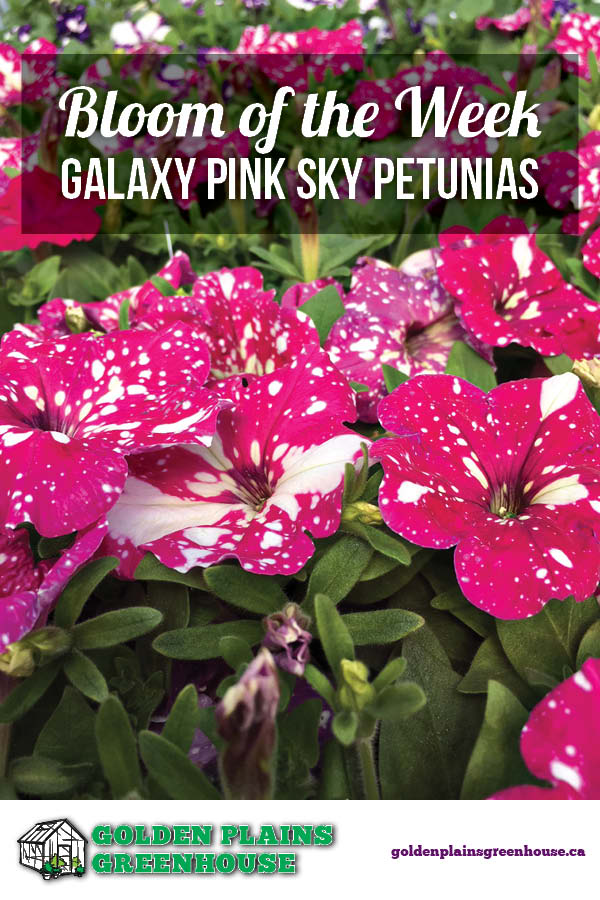
Galaxy Petunias boldly go where no Petunia has gone before!
Last year we introduced you to Night Sky, this year, say hello to Pink Sky! The white splashes on a background of deep pink creates an incredibly eye-catching contrast. Each bloom is uniquely patterned; no two are alike. The reason for this that the density and size of the white speckles vary depending on temperature, light and soil PH. Warmer weather brings out more of the pink background, whereas cooler weather will bring out more of the white splashes. To achieve the perfect balance of pink to white, it's best to have warm days and cool nights.
Pink Sky Petunias forms a mounded yet gently trailing plant that will look amazing in hanging baskets and containers, as well as make a great ground cover. Pair with it's sister, Night Sky for a gorgeous purple/pink combo or perhaps add some texture difference with a white Bacopa and a Sweet Potato Vine.
Remember to deadhead, meaning removing the dying flowers from the Petunia. Make sure to remove the base of the flower to include seed removal. Petunias allowed to go to seed will slow or stop blooming. You may notice by midsummer, Pink Sky, like all Petunias, will begin to get a bit leggy and the stems will start to produce fewer blooms. Cut each stem back by half to rejuvenate the plant. After a short break, they will return to flowering. You know what I really love? Blackberries. They are awesome for fresh eating, amazing in jams and superb in pies! You know what I really hate? Blackberries. There is nothing worse than going to pick Blackberries and coming out with a scratched and bleeding arm. Those thorns are more than just annoying, they are dangerous! Okay, I may be exaggerating a bit with the word "dangerous", but I'm not kidding about the scratches, cuts and blood (it may be just a little blood though). Well, if you would put yourself in the same boat as me (or should I say bush??), there is hope on the horizon for us. I would like to tell you about the Black Satin Blackberry, this beauty is thornless. That's right, I said thornless!
Once you do let the fruit come in the second year, it will produce heavy crops (35-40 berries per stem) of large, golf ball sized berries. Smooth and glossy, the fruits are super-sweet with no sour bite. The berries are excellent for jams, jellies, pies and fresh eating, also they keep very well. Black Satin Blackberry bushes are self-pollinating, but are more productive when planted with another variety.
So to recap, you can now have thornless Blackberries. It is now time to Carpe Diem! Or at least, Carpe some Blackberries! You know, I've often wondered why people plant flowers in their veggie gardens. To my untrained eye, my only theory was that people wanted to make their gardens pretty. I thought it was weird, but you know, to each their own! Well, it turns out I was wrong (an uncommon occurrence, I can assure you!), and perhaps I can go so far to say I was only partially wrong. Flowers, regardless the reason they're put there, still make a veggie garden look prettier! So the real reason is, drum roll please... companion planting! After I did some investigating, this turns out to be almost a science on it's own! Today I will only touch on the relationship between flowers and veggies, but I will be making another blog post (or maybe several) about this subject in the future that will expand past flowers. Marigolds
Nasturtiums
Lavender
Petunias
Sunflowers
There is nothing quite so poetic as watching a butterfly flit from flower to flower on a warm summer's day in the garden. If this is a scene you want to help encourage, the best thing you can do is to plant nectar producing flowers to help attract these graceful fliers to your garden. One of the most popular choices to help attract butterflies is Tuberosa Asclepias, also known as Butterfly Weed. Not only do they provide a source of nectar for them, but they also act as a host for the eggs of Monarch butterflies.
If you are interested in producing more than just a feeding ground for butterflies, but a sanctuary where they can grow and multiply, there are other steps you can take to help create a butterfly haven.
Check out the North American Butterfly Association for more information on creating a butterfly garden.
Did you know? Have you heard? This year is the 150th anniversary of Canada becoming a country. I have to admit, that is pretty exciting. That is 150 years poutine, 150 years of hockey, 150 years of the true North strong and free, that's 150 years of everything that makes us Canadian. Can you tell I'm proud to be a Canadian?!?
To go with this event, the people at Vineyard decided to create a Rose that would help every garden join in the celebration and we have them in stock for you! Introducing the Canadian Shield Rose:
Canadian Shield is a versatile garden and landscape Rose with a 3 ft. height and width, and full, silky-textured red flowers and glossy green foliage. It’s a repeat bloomer, resistant to blackspot and winter hardy from coast to coast. Hence the name Canadian Shield!
You can trust in its hardiness as this beauty was started right next door in Morden, MB as a federal breeding program to create rose varieties that could cope with our extreme Canadian temperatures. Vineyland Research Station (located in Ontario) took over the program and helped finish bringing this Rose to market.
The only reason to prune back a hardy Rose is that it has grown extremely tall (over 3 ft.). In this case, it should have their branches cut back to 3 ft. in the fall to prevent ice damage.
Canadian Shield Roses are such a unique way to commemorate Canada's sesquicentennial. That's right, I said sesquicentennial... Well maybe I just typed it! So pop by the greenhouse and have a look at these brilliant, red blooms for yourself. Add a little patriotism to your garden this summer! 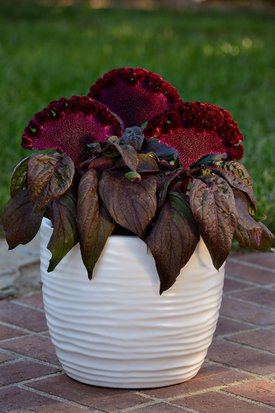 Let's just get it out in the open, right from the beginning... I'm not a big fan of Celosia. There I said it. This has to be one of the most unique looking "flowers" out there. I did put the quotation marks around the word flower on purpose. This "flower" doesn't have petals, depending on the variety, it will have spires or cockscombs. Celosia flowers, with their unusual blooms, can "flower" up to 10 weeks. When many of these "flowers" are next to each other, they collectively resemble fire, which is why the name Celosia, meaning burning in Greek, was chosen. Perhaps I'm a traditionalist, I expect my flowers to have petals. But then, Dracula Celosia arrived in the greenhouse. I have to admit, the name alone intrigued me enough to take a closer look and I'm glad I did! I may be a Celosia convert. Perhaps my flowers don't need to have petals, perhaps they can have spires, perhaps I would like a cockscomb in my garden! Dracula, a novelty Celosia, is new for 2017. It is the first of its kind, with one large 6-7 in. "flower" on top of each plant. In the greenhouse, the combs are red and the foliage is green with some red, but once you take this lovely beauty home and plant it in your own garden, the foliage will get darker and change to purple tones. The come will also start to change to a darker purple colour. With its unusual shape and eye-catching colour, Dracula Celosia will add drama to your landscapes, gardens and containers. 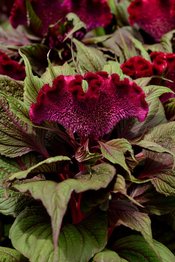 To grow your Dracula Celosia, make sure to plant in full sun. They need rich soil with lots of compost to produce their big, dramatic plumes ('cause you know I can't call them blooms or petals!). Make sure the soil is moist, but not wet and that it drains well. Water them regularly during the dry periods. Add a general purpose fertilizer one or twice a month. To produce more plumes, pinch back the first one. This may make you nervous for those first bright cockscombs, but have faith! This will promote more branching and reward you later. Create a little excitement with this show-stopper, pair with an African Marigold such as Lady Orange or a Snapdragon; the Merlot Mix from the Snapshot series would be lovely with the Dracula Celosia. So why not take a chance this spring and try something new and different? 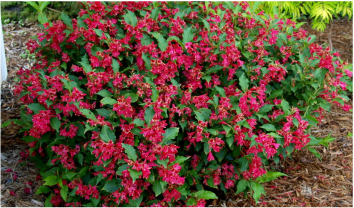 Red Prince Weigela are highly prized for their dark pink to red flowers. These blooms are out from late spring all through summer and appear in clusters against a backdrop of dense, medium-green foliage. The blooms attract hummingbirds like magnets! Weigela is a tough and easy deciduous flowering shrub. For best flowering and growth, provide these shrubs with full to partial sun and average to fertile soil with good drainage. They look super in mixed borders or as hedges. Prune them back to strong new side shoots in summer after they bloom. Shearing them destroys their natural arching habit. When planting the Red Prince weigela, there are a few things to keep in mind:
I'm probably the only one who finds the title of today's blog post about using wood ash in the garden funny, but hey, life is short so I thought I'd take a chance! Some say I have a great sense of humour, but well... it's only some :-) So, anyways, onto today's topic: wood ash. If your like us, on summer nights (spring and fall too if the weather co-operates) we love to have people over for a backyard campfire. Enough so, that the ash from the wood we've burnt has piled up and needs to removed to somewhere before the next fire. So, where to move it to???  Well, as it turns out, you can use that ash in the garden! But before you go ahead and dump vast quantities of ash into your soil, there are a few things you should know: Wood ash can be a great addition to the garden, mind you, it does have to be pure wood ash. No bits of garbage, cardboard or pressure treated, painted or stained wood. This ash contains most of the 13 essential nutrients the soil must supply for plant growth, including calcium, potassium and magnesium. Root vegetables such as carrots, parsnips, turnips, peas and beans will do great with a little bit of added ash, some fruits as well such as raspberries, blackberries and strawberries. Underwater plants can also be strengthened by using 1 spoonful per 1000L of water. 0.5 - 1 lb. per year is actually recommend for shrubs and rose bushes. It's best to spread the ash evenly on the soil around the plants and rake it in lightly, being careful not to damage the roots. Never leave ash in lumps or piles as the concentrated salt leaves will leach into the soil creating a harmful environment for the plants. Another benefit is that wood ash can be used to help repel insects, slugs and snails. However, once the ash gets wet, the wonderful repelling effect it has vanishes. However, this being said, being alkaline, wood ash obviously isn’t an ideal addition if your soil already has a pH of 7.0 or greater. Regardless of your pH, it shouldn't be added around acid-loving plants such as blueberries or potatoes either as it can encourage the growth of "potato scab" which is a fungus. Newly germinated seedlings are another thing to stay away from as the ash contains too many salts for them. So ash I see it (I did it again), using wood ash in the garden has many natural benefits. So I say - go ahead - have those backyard campfires! Roast some marshmallows! You'll only be helping your vegetables if you do :-) 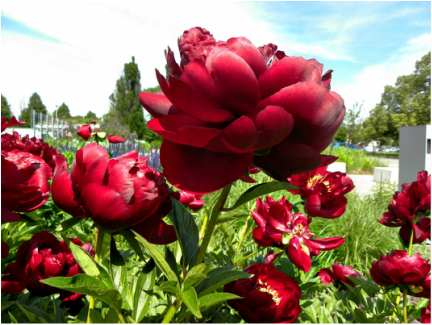 Buckeye Belle peonies are an early-flowering, ruby red peony. This semi-double has glossy outer petals that loosely follow the curving contours of a wide brandy glass. These enclose a ruffled taffeta middle of fimbriate red petals set among golden stamens. The foliage has an emerald green tint. When sunlight strikes, this peony is a jewel in the late-spring border. These peonies make excellent cut flowers. Good Companions Peonies mix well with roses because most share the same foliage tones of glossy copper-red. Although peonies flower for two weeks on average, their handsome foliage carries them through spring, summer and autumn. Also, they add structure and form to a border and can be planted with later-flowering annuals such as cosmos, or used with penstemons. Growing Tips
|
AuthorHello! My name is Lee Ann and I am the daughter-in-law to the Giesbrechts. I have learnt much about gardening from helping out in the greenhouse, but I hope that through writing this blog, I will learn more and be able to share the things I have learnt with you! Archives
June 2018
Categories |
ShoppingOur Plants
Our Goods Company |
hoursSale Season Hours
Monday - Friday 9am-6pm Saturday 9am-4pm Sunday closed Last day of the season June 26 2024 |
